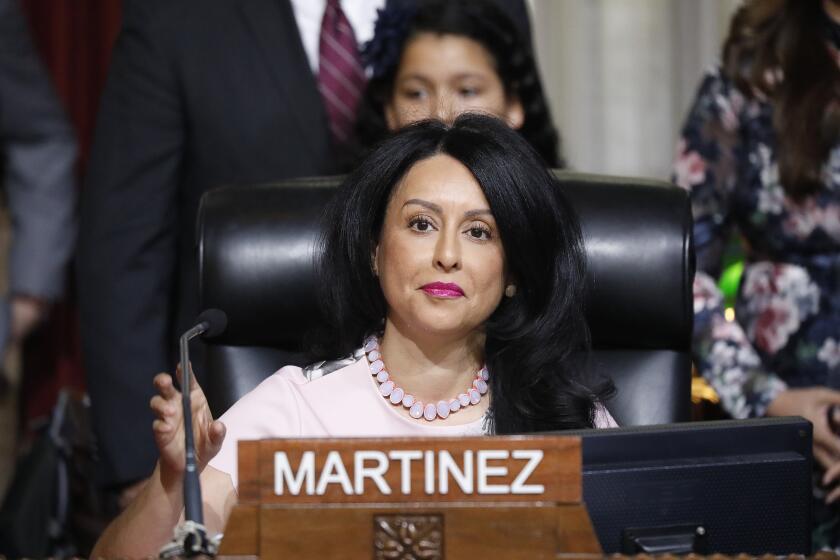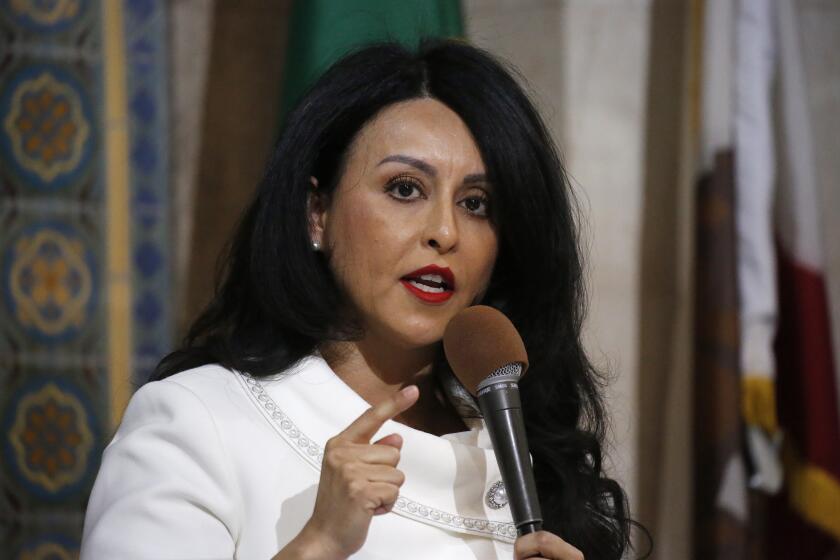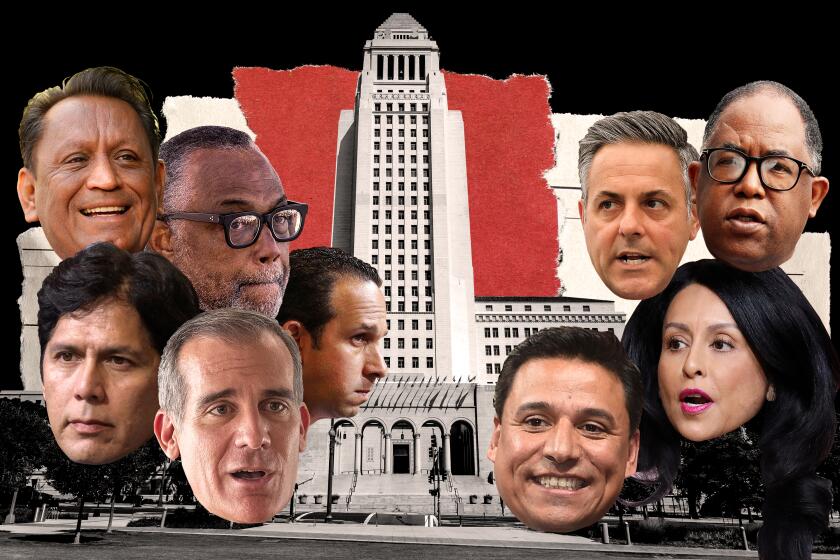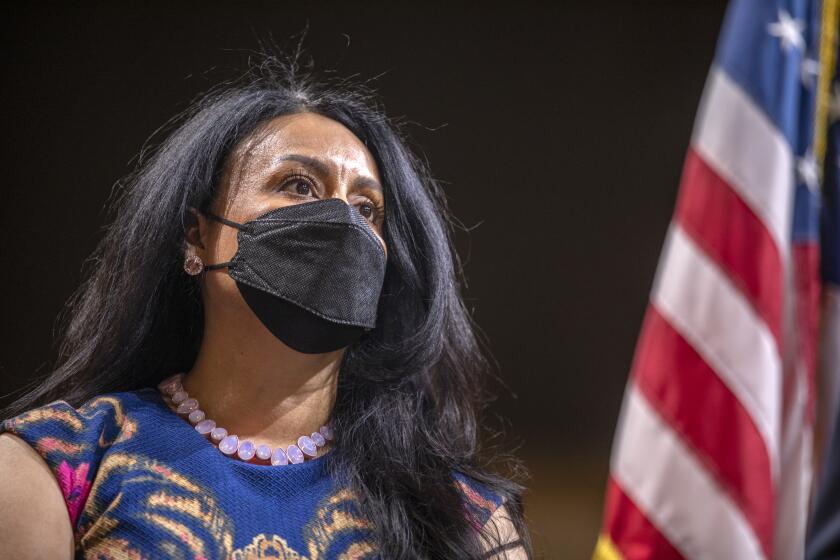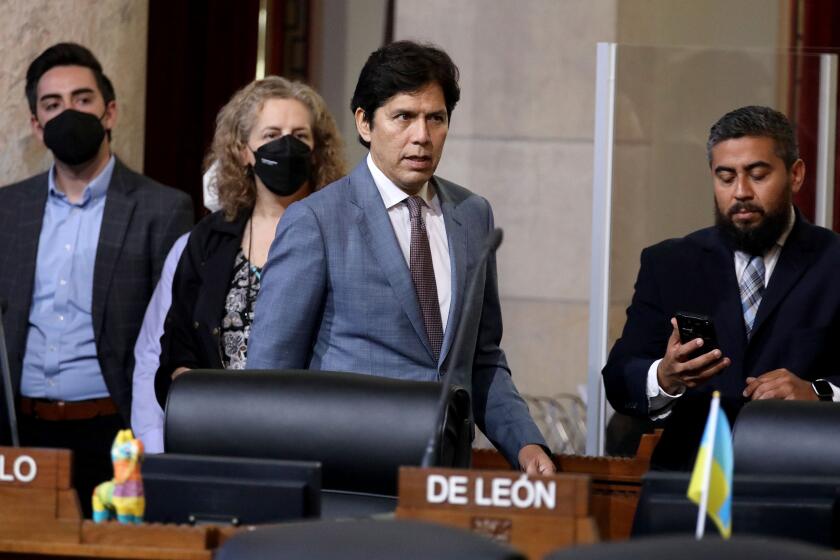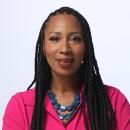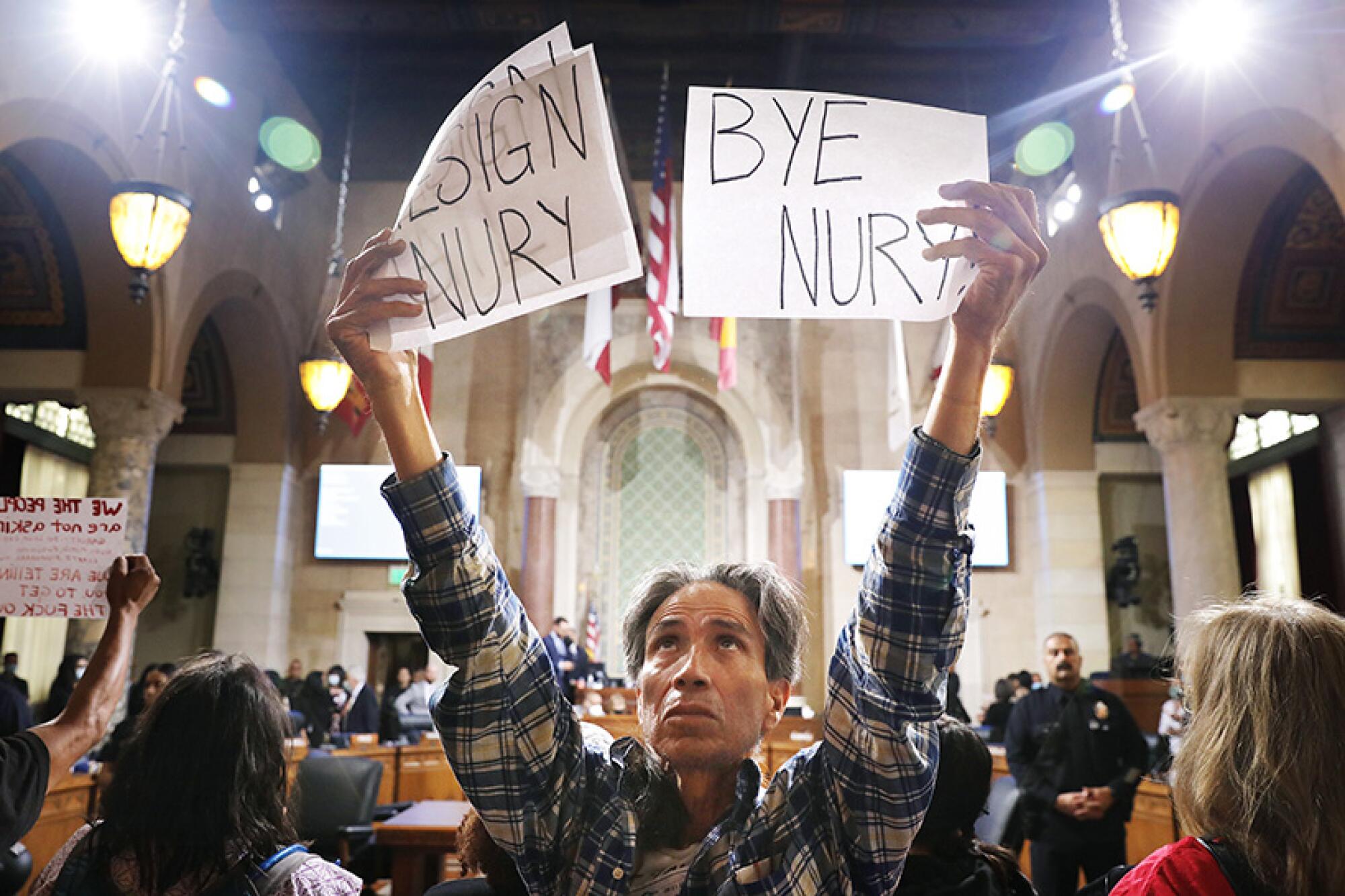
Jorge Nuño learned the hard way how race, power and politics work in Los Angeles.
Nuño, 45, the son of immigrants from Jalisco, Mexico, grew up in South Los Angeles near Vernon Avenue and Main Street, then built a successful graphic design business and a printing business, launched a multiracial youth services nonprofit, and threw himself into grass-roots organizing among both Black and Latino groups in his neighborhood.
With this background, he decided to run for City Council representing the 9th District — its constituents majority Latino — expecting his campaign would garner at least some interest from the city’s traditional Latino establishment.
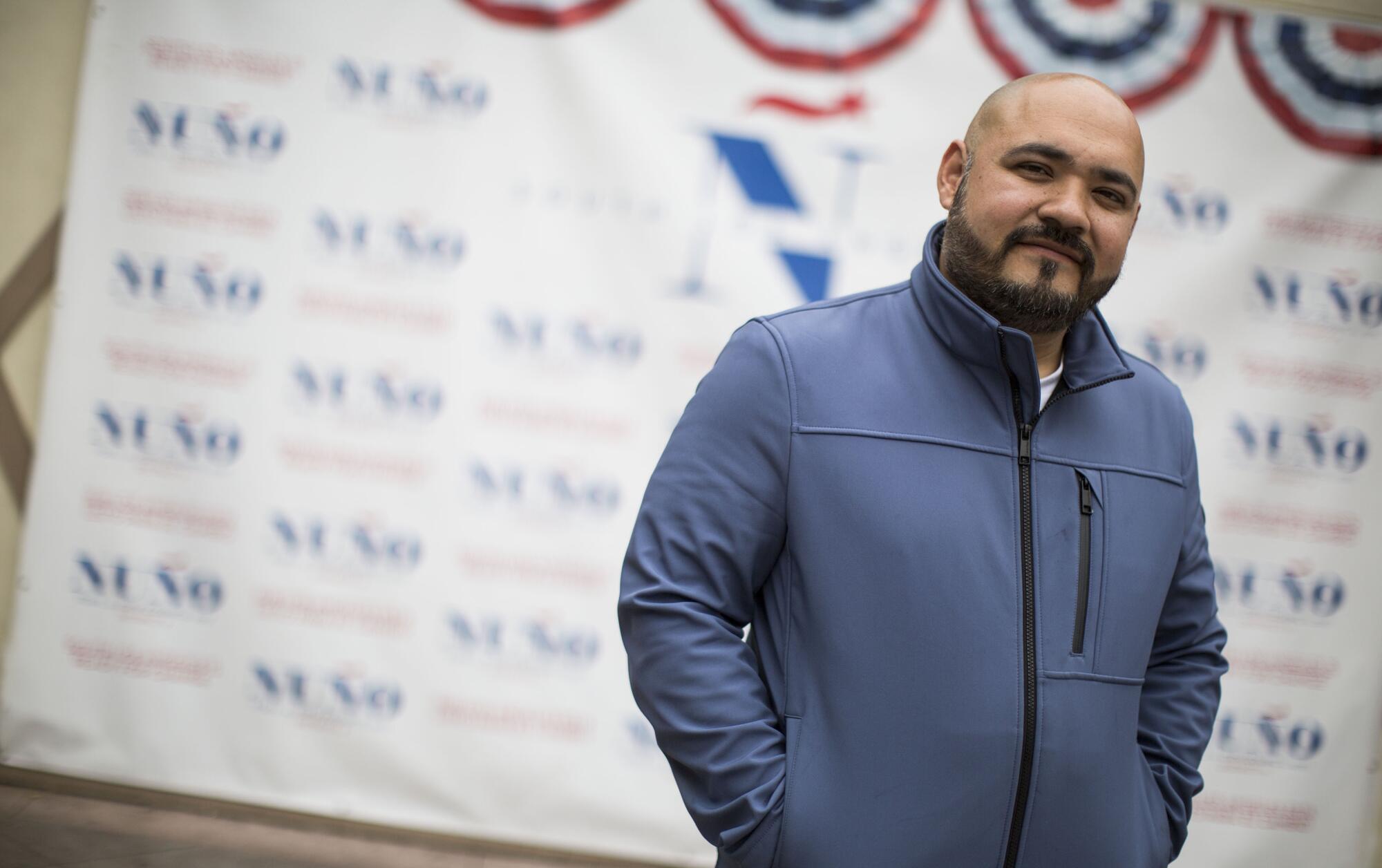
Instead, word filtered down: No way.
“What I heard was that no Latino [power brokers] are going to come support any candidate coming out of South L.A.,” he said, “because there is a coordination between Black and brown caucuses about keeping it Black” through the tenure of the current councilman.
With Los Angeles still reeling from a leak revealing prominent elected officials making bigoted and racist remarks, much about the recording remains a mystery: Who made it? And how? Who leaked it? And why?
Nuño lost that election to the incumbent, Curren Price, a Black former state lawmaker who also grew up in South L.A. He said he simply did not understand the complicated alliances brokered by Black and Latino politicians and their allies in labor.
“Naive to the game,” he said of himself back then.
City government has been thrown into crisis by the racist rhetoric of a secretly recorded conversation in which three Latino councilmembers — Nury Martinez, Gil Cedillo, and Kevin de León — plotted electoral strategy with a labor leader. The language was so outrageous that President Biden waded into city politics, calling on them all to resign.
Nuño said he too was sickened by the racism, but he said he was also struck by what the conversation revealed about the complex way politicians use race to exercise power in a sprawling multicultural city. Even as she said terrible things about Black people, including comparing a colleague’s Black child to a monkey, Martinez kept circling back to one of her major political goals: helping Price — a Black councilman representing a district that is now fourth-fifths Latino — hold on to his seat against a Latina challenger.
A leaked recording of L.A. City Council members and a labor official includes racist remarks. Council President Nury Martinez apologizes; Councilmember Kevin de León expresses regret.
Politics in Los Angeles has always been organized along racial lines. But those lines are not as stark as the crass and hateful language on the recordings might lead many to conclude. Instead, in a city where more than 100 languages are spoken, leaders have put together coalitions to win elections and move their legislative priorities through the City Council, where eight votes are required to approve anything. And in the last three decades, the center of those coalitions has often been an alliance between Latino and Black leaders.
An enduring, fragile alliance
That alliance, which often includes strong backing from organized labor, has achieved major progressive goals, winning one of the highest minimum wages in the country, for example, and pushing initiatives to benefit renters, immigrants and neighborhoods long beset by environmental hazards.
For much of the last few decades, Black and brown leadership provided vital focus on social issues in core areas of L.A., as many whites moved to suburbs and wrote off older neighborhoods in the central city as no-go crime zones.
Audio of Councilmembers Nury Martinez, Kevin de León and Gil Cedillo speaking with labor leader Ron Herrera quickly became a new and incendiary issue in the Nov. 8 election.
But the foundations of that alliance are threatened by the shift of the demographics it was built on: the Latino population has grown rapidly for generations while the number of Black people has continuously decreased. Over the last four decades the Latino share of the city’s population has grown from 27% to 48%, while the Black share has dipped from 17% to just below 9%.
A critical factor in keeping the alliance alive and essential: high Black voter turnout to counterbalance the decline in numbers of residents.

Martinez, Cedillo, De León and Herrera have been as skillful as any at building and maintaining these Black-brown coalitions, which made the racist tape all the more shocking.
“I think that is exactly why people are so offended, because that is not who we are,” said Councilman Marqueece Harris-Dawson, who is Black and represents South Los Angeles’ 8th Council District. He predicted that “coalition politics in Los Angeles comes back stronger than ever now.”
“The path to prosperity in Los Angeles is through a Black-brown coalition,” he said.
::
The long fight for a seat at the table
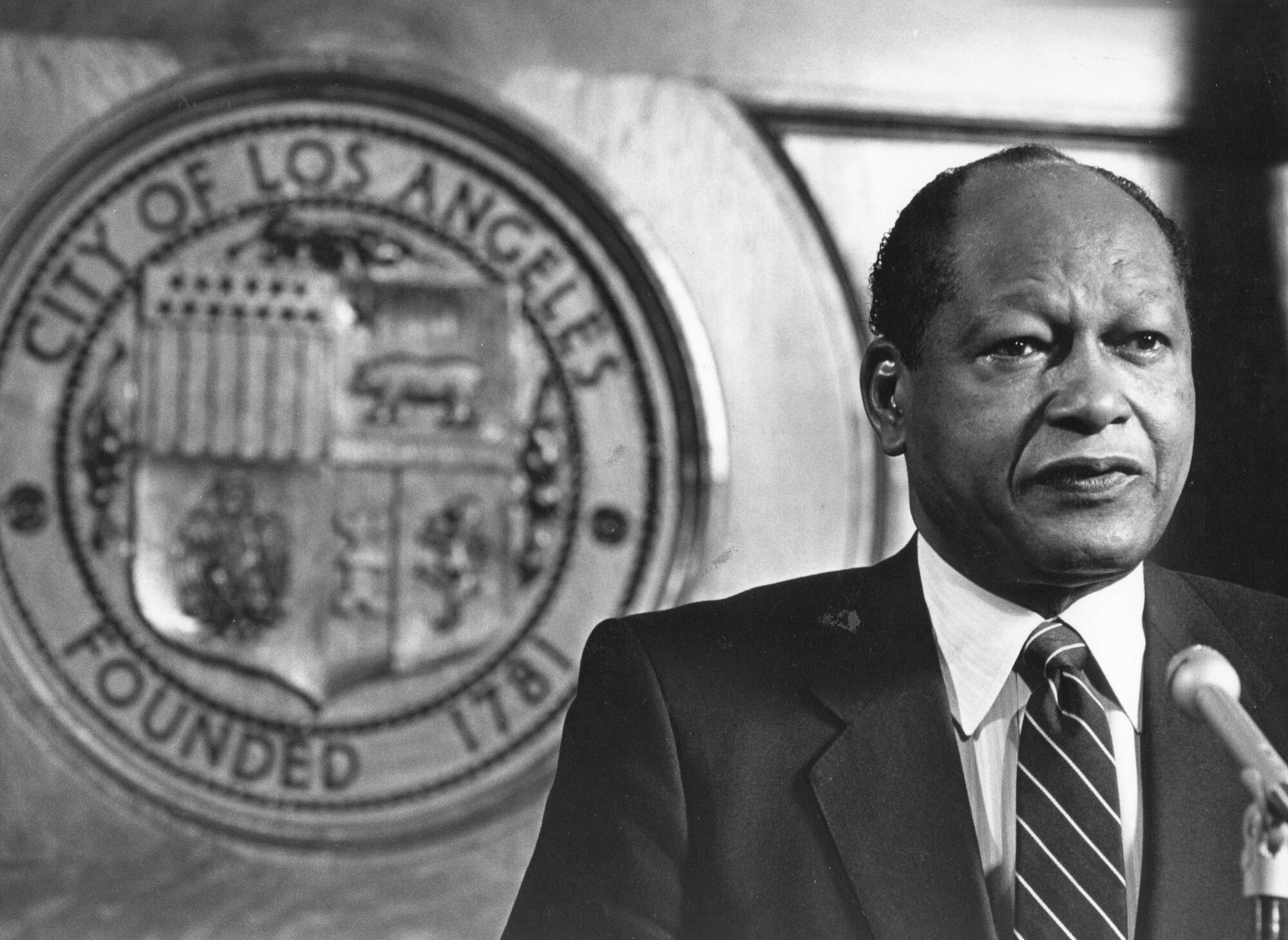
The framework for modern coalition politics built across racial lines in Los Angeles, and, in many ways, the nation as a whole, was forged in the early 1970s when Angelenos elected Mayor Tom Bradley, the son of former sharecroppers and the grandson of slaves.
The Los Angeles political world is no stranger to scandal. In fact, there have been so many it can be hard to keep them straight.
His election, making him the first Black mayor in Los Angeles, but also one of the first in any major city in the nation, became a defining narrative in American politics — a win credited to his broad support among many groups in the city, but anchored by Black and Jewish voters.
Until the 1950s, Los Angeles was a city that offered essentially no political access to Black, Latino, Asian and Jewish Angelenos, according to Raphael Sonenshein, executive director of Cal State L.A.’s Pat Brown Institute for Public Affairs.
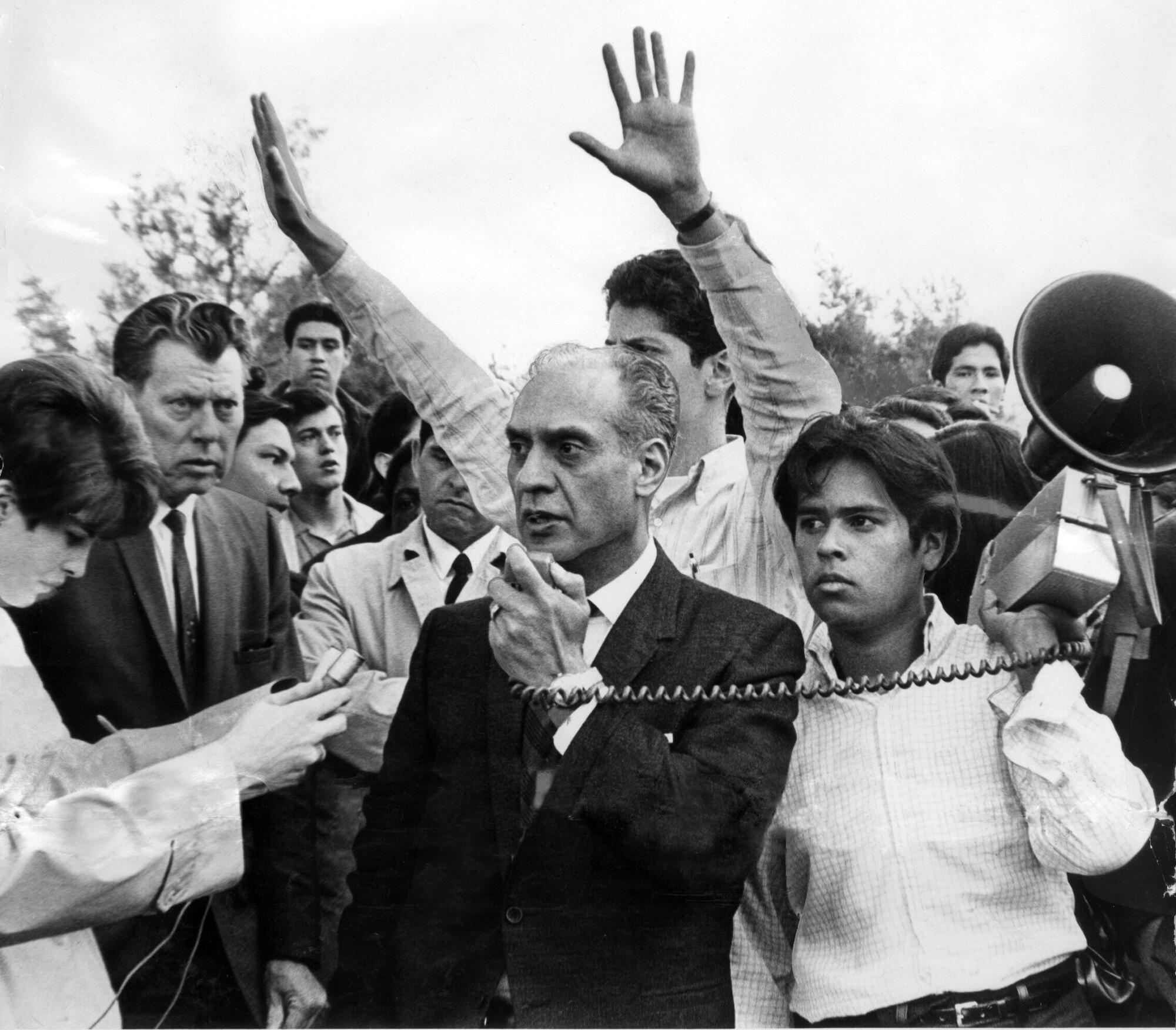
The first real break in that status quo, he said, came with the election of Edward Roybal to the City Council in 1949, making him the first Latino to serve in the role in nearly 70 years. (In an interview years later, Roybal recalled that at his first City Council meeting, he was introduced as “our new Mexican councilman who also speaks Mexican.”)
In one of the first and most powerful examples of the Black and Latino communities working together to advance common political goals, Roybal in 1962 supported the appointment of Gilbert Lindsay, who was Black, to take over his seat when he left for Congress.
“Progressive politics in Los Angeles is fundamentally coalition politics,” said Sonenshein.
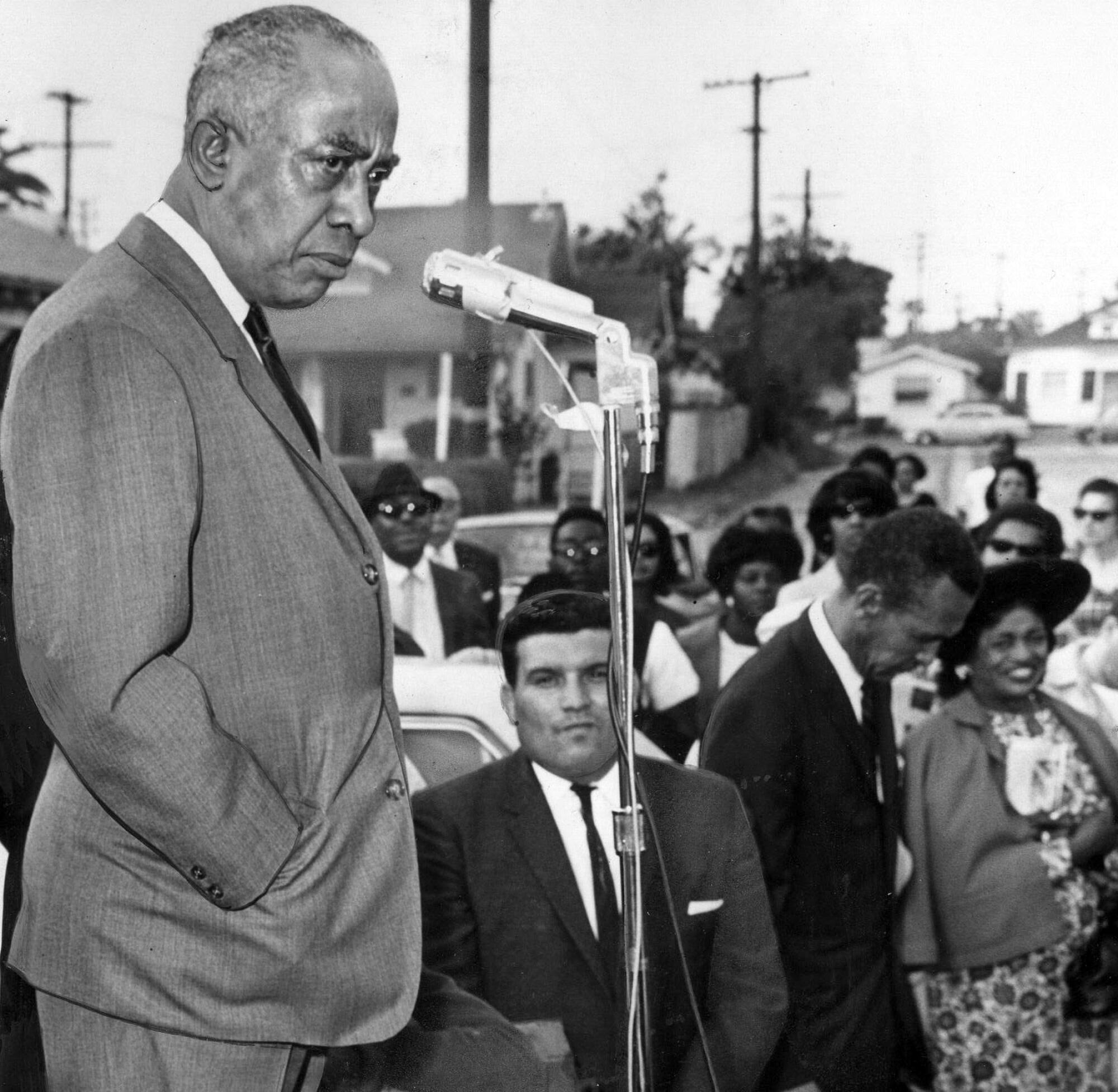
Nowhere is that more true than in South Los Angeles, the sprawling land of farms and agricultural fields that gave way to white suburbs before it became a Black space and then, in more recent decades, a majority Latino area.
Between the 1940s and 1970s, hundreds of thousands of Black people moved to the area amid a labor shortage and a manufacturing boom in the wake of World War II.
Housing covenants prevented Black Angelenos and other minorities from living in other parts of the city, while in South L.A. banks and insurance companies denied loans and insurance policies, keeping the area economically depressed and increasingly dilapidated. When Black people finally defeated housing discrimination policies in court, some moved into the middle class. But South L.A. just became impoverished and neglected, served by substandard schools and hospitals, patrolled by a hostile police force, and otherwise largely ignored by City Hall.
In the same audio clip in which she disparages Black people and Oaxacans, Nury Martinez insults Jews and Armenians too.
In the 1980s, thousands of Latinos began moving into the area, many displaced by the civil wars in Guatemala and El Salvador, and economic strife in Mexico.
Their arrival also came as the manufacturing jobs disappeared and crack cocaine became an epidemic.
During that era, Sylvia Castillo, a Latina pediatric nurse, teamed up with her friend Karen Bass, a Black emergency room physician’s assistant. Castillo and Bass — now the front-runner in the city’s mayoral race — were heartsick about the way the drug was ripping through their community, particularly what it was doing to the children of drug-addicted parents. They began going door to door recruiting residents who wanted to organize to build better services for the neighborhood.
“We knew if we were going to organize that we needed to do it around our power base, which was Latinos and African Americans,” Castillo said. “We knew they were invested in their children and their futures.”
The Community Coalition was officially founded in 1990 and focused on addressing the nuisance of liquor stores and motels that contributed to prostitution and drug sales. They also wanted to change the way their neighbors were treated by the Los Angeles Police Department.
“We understood there were forces that would have liked to keep us divided,” she said. “But if we continued to be divided then we wouldn’t have power to leverage and get resources for our neighborhoods that were being decimated by the drug epidemic and incarcerations.
“We had a common ground,” she added.
::
Uneven gains in a rapidly changing city
Black people were the first to consolidate their electoral power and take seats around the ornate City Council horseshoe.
Two years after Lindsay took the 9th District seat in 1961, an LAPD lieutenant named Tom Bradley won his first council race in 1963, representing the 10th District, the same year that a Black lawyer Billy G. Mills took the 8th council seat. The three districts have had Black representatives ever since.
Latino leaders, meanwhile, were increasingly feeling as though their voices were not being heard. After Roybal vacated his desk, it would be 23 years before another Latino succeeded in winning a council seat.
While the Latino population reached 27% of the city by the 1980 census, Latinos remained locked out of the council chambers where leaders drafted the policies and laws that governed life in Los Angeles.
Their opening came in 1985, when a white councilman, Art Snyder, suddenly resigned his seat representing the 14th District — stretching across rolling brown hills from El Sereno to Boyle Heights — an area that was 75% Latino.
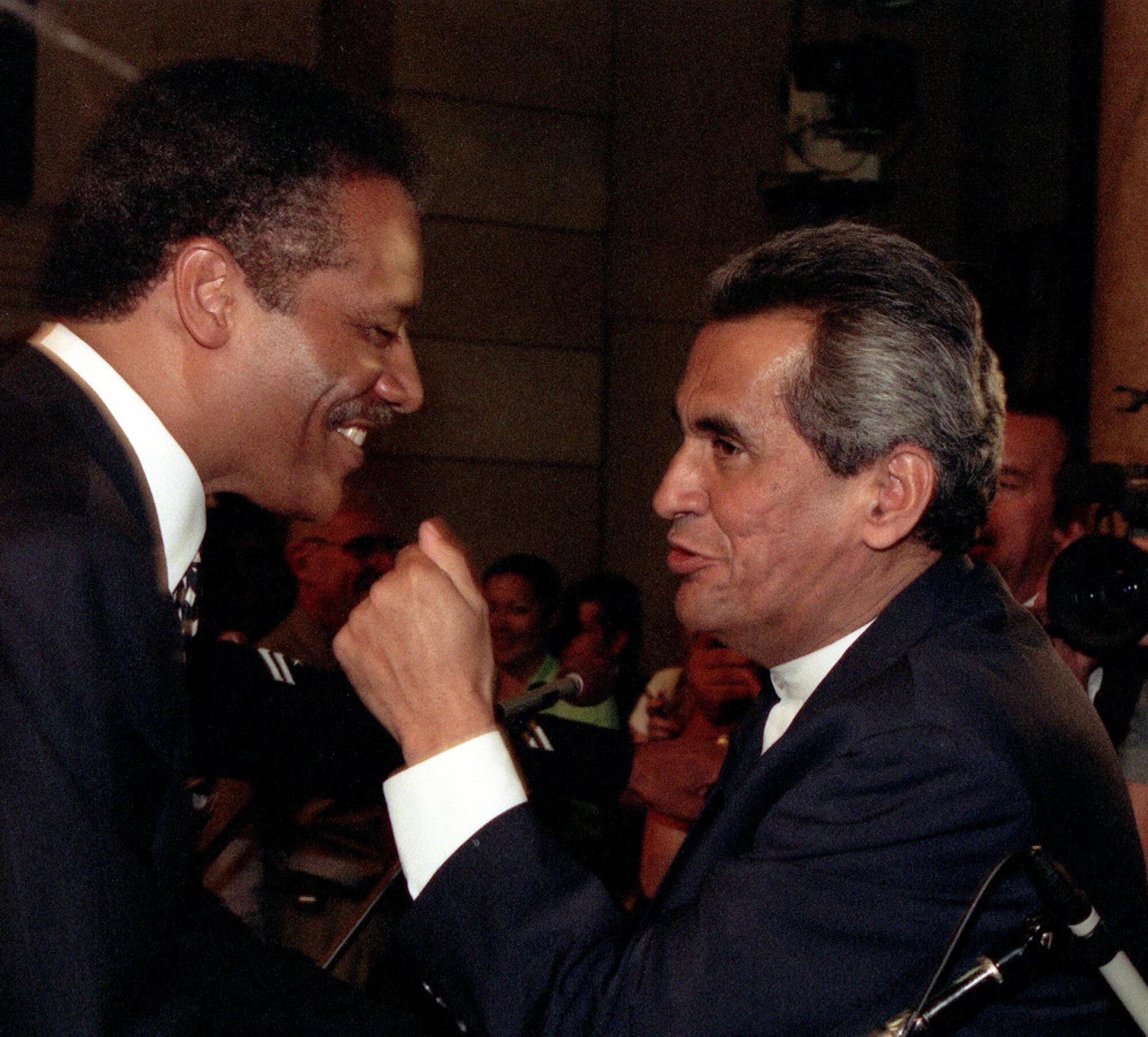
Richard Alatorre, the son of an East Los Angeles beautician and repairman, who served 13 years in the state Assembly and was a close ally of California’s first Black speaker, Willie Brown, decided to run for the seat to, as he put it at the time, “serve the people more directly and more immediately.”
Brown told him he was crazy to relinquish his powerful position in Sacramento. “‘What the hell do you want to do that for?’” Alatorre recalled him saying. “‘Follow barking dogs and stuff like that?’”
Alatorre announced his candidacy at a news conference in the Plaza de la Raza in Lincoln Heights.
In the middle of his campaign, the U.S. Department of Justice filed a civil rights lawsuit against the city of Los Angeles and its elected leaders, charging “a history of official discrimination” against Latinos and seeking to overturn the city’s 1982 redistricting plan for council districts. The suit charged that city officials intentionally had drawn district lines to disperse Latinos and dilute their political power.
“There has been a history of official discrimination by the State of California and the City of Los Angeles against Hispanic residents of the city,” the suit alleged. “Such discrimination has included discrimination touching on the right of Spanish-speaking and other language minorities to register, vote and participate in the political process.”
Two weeks later, Alatorre won his election despite the alleged gerrymandering.
He was appointed chair of the reapportionment committee, in charge of coming up with new district maps that would meet with the Justice Department’s approval.
Within months, Alatorre’s plan had infuriated the council’s first Asian member, Mike Woo — elected the year before — after he proposed moving his 13th District east and out of Hollywood, making the district two-thirds Latino.
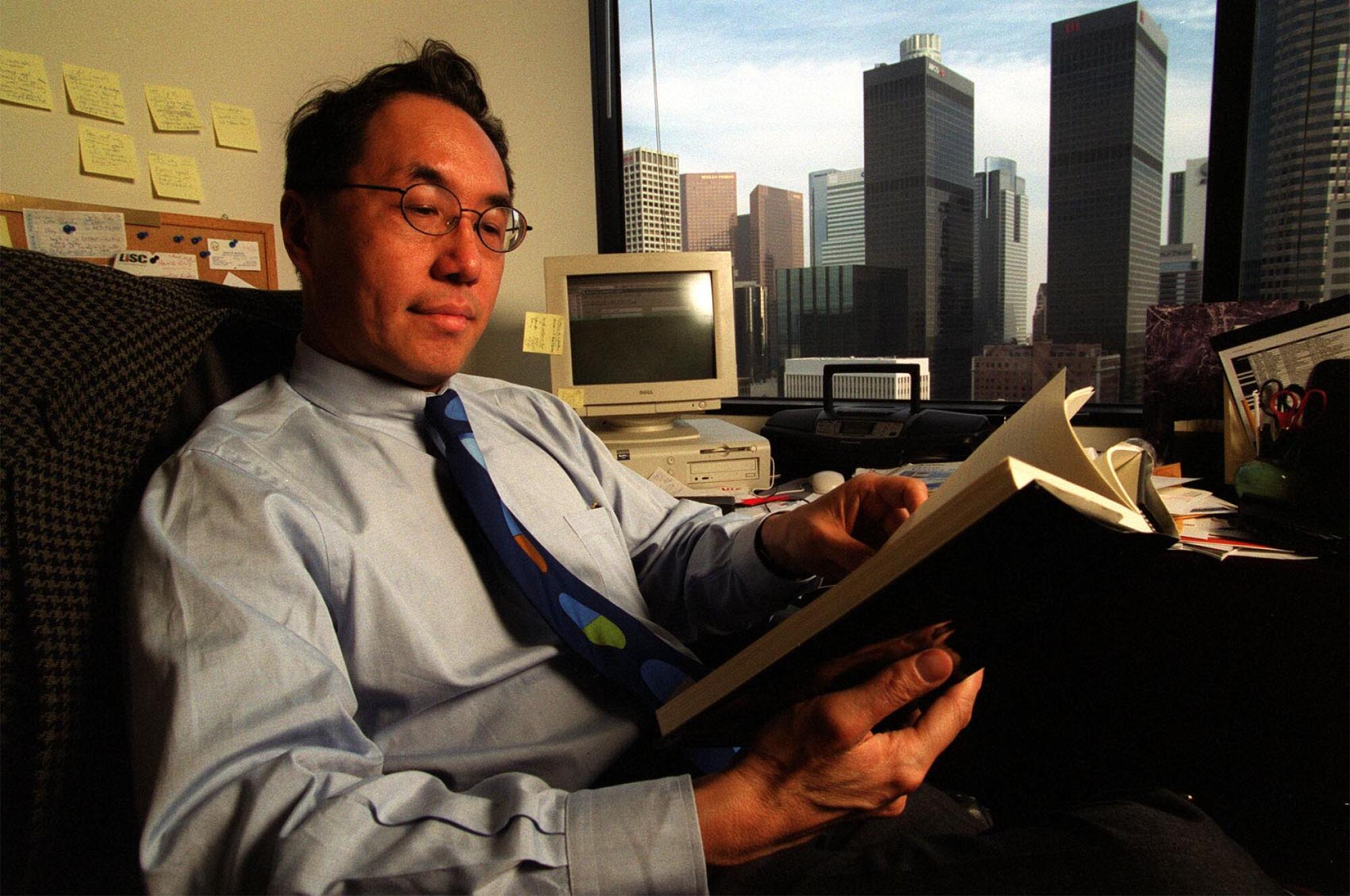
Part of Alatorre’s rationale, according to coverage at the time, was to protect the council’s three Black seats.
By then, the 9th District was 40% Latino and, with slightly altered lines, could have become a Latino seat.
But Alatorre promised the council’s three Black members — Lindsay, David Cunningham and Robert Farrell — that he would leave them alone.
“Hey, I like to win,” Alatorre said at the time. Part of winning, he said, meant “not going after the Black districts. I decided I wasn’t going to do that because then we could be accused of doing to Blacks what the Justice Department says we did to Hispanics.”
To be legally defensible, maps need to comply with the Voting Rights Act, meant to safeguard Black and Latino representation. But a delicate balance is required, in that race cannot be the “predominant” factor when drawing maps; that would violate the equal protection clause of the 14th Amendment of the Constitution.
When the final plan was approved by the council in the fall of 1986, Alatorre had managed to carve out a second Latino council district — the seat now occupied by Gil Cedillo — stretching north and west of downtown. The next year, Gloria Molina won that seat to become the first Latina on the City Council.
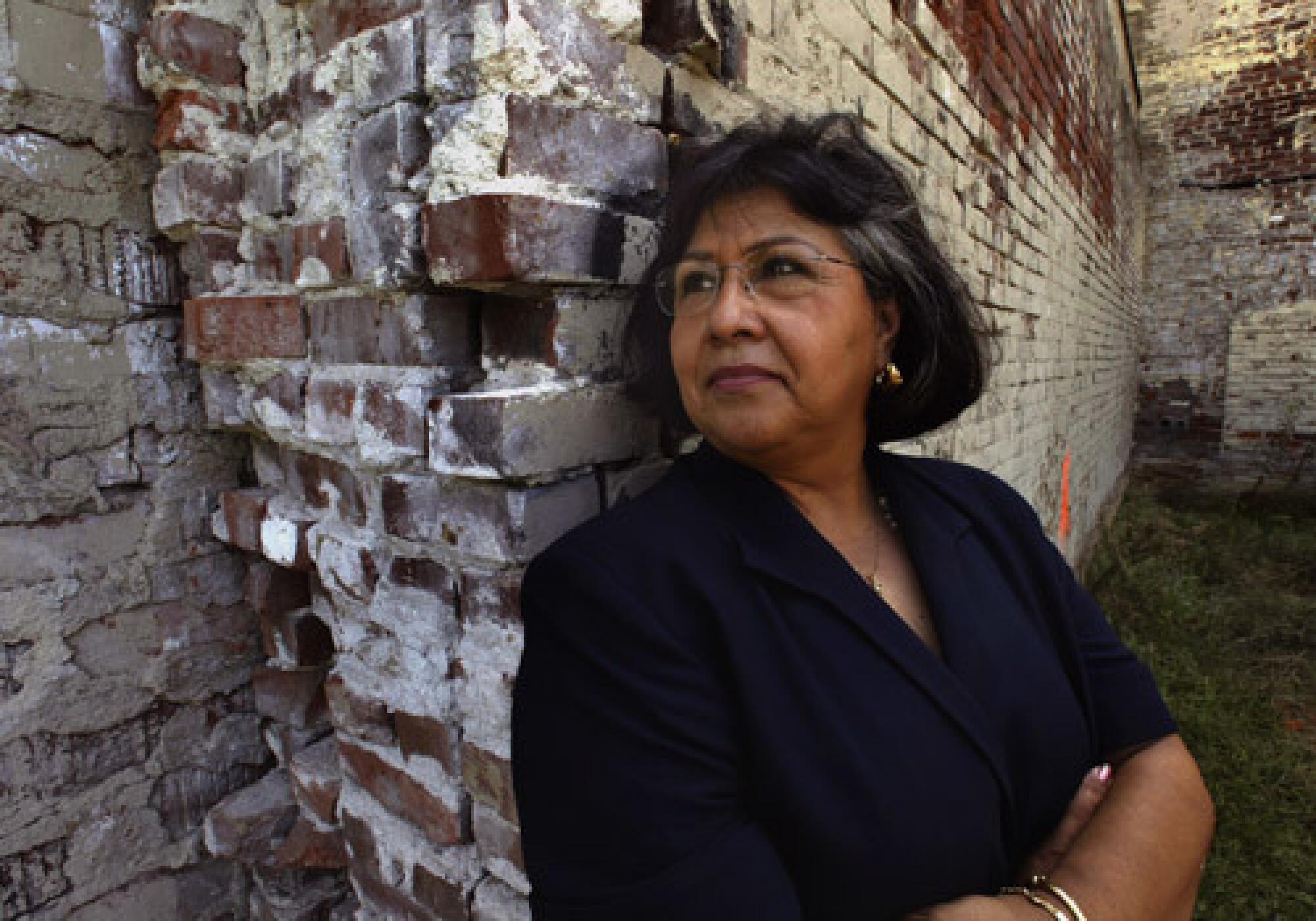
She quickly began pursuing laws and policies that reflected longtime concerns of residents in her district — and in Black districts — such as sweeping streets in neglected areas and building affordable housing. When she left the council in 1991 to become the first Latina on the county Board of Supervisors, Mike Hernandez, a young activist from Cypress Park, was elected to fill her spot.
Two other new members, Mark Ridley-Thomas and Rita Walters, both Black and elected to represent districts in South L.A., joined the council at the same time as Hernandez.
The city of Los Angeles lets elected officials draw the lines of their own districts in the decennial redistricting process. That’s why “asset gerrymandering” is a thing in L.A.
This all came during a fraught time for Los Angeles that would challenge the coalition and the rest of the city.
After a successful Olympics in 1984 reinforced the city’s image of L.A. as a multicultural success story, led by Bradley, conditions took turns for the worse. Crime spiked. The LAPD under Chief Daryl Gates reacted with aggressive, brutal policing in Black and Latino neighborhoods. Residents decried their treatment. But many felt that the white power structure didn’t care about what was going on in their communities — whether it be the policing, the poverty, or the mass loss of jobs as the aerospace industry declined and other manufacturing left Los Angeles.
Communities burn, demand change
Then came the civil uprising that would forever change the city and burn parts of their districts to the ground.
On April 29, 1992, when an all-white jury acquitted the white police officers who had brutally beaten Rodney King, furious residents poured into the streets near Florence and Normandie avenues in South L.A., setting off days of violent unrest.
In the smoky aftermath, the three leaders fought for government resources to rebuild, trying to fix the destruction in districts that been starved of services for generations.
A year later, Hernandez and Ridley-Thomas convened a news conference at City Hall to discuss the results of a study about how the unrest harmed the Latino community.
The study found that Latinos made up 49% of the population in areas most affected by the uprisings and that immigration officials had taken advantage of the chaos to detain hundreds of people they suspected were undocumented. Improving economic opportunities for Latinos, the study’s authors wrote, was critical to rebuilding efforts in the city.
Meanwhile, Latinos were slowly getting more political representation in City Hall and beyond, but always at a percentage far below their numbers in the city at large.
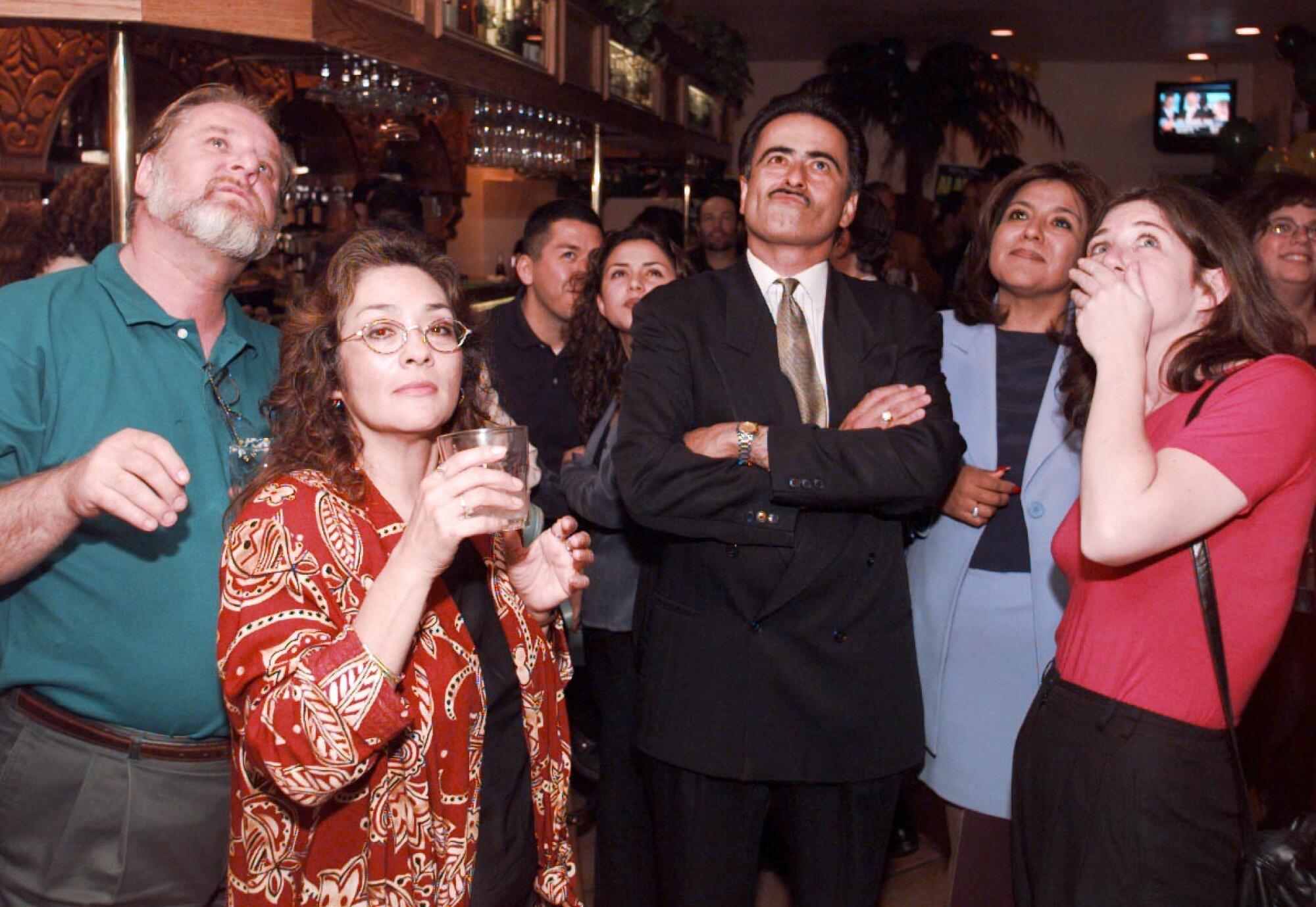
Following the 1992 redistricting, Richard Alarcon became the first Latino elected to the council from the San Fernando Valley. When he moved to the state Senate in 1999, he was succeeded by Alex Padilla, then a young MIT graduate from Pacoima, who is now California’s first Latino United States senator.
Year after year, the Latino councilmembers found common cause with the three Black councilmembers from South Los Angeles.
Together, they pushed for gang-intervention programs, after-school programs, improved transit, and reformed policing. In 1997, when Mayor Richard Riordan appointed Bernard C. Parks, who is Black, as the police chief, Alatorre was one of his biggest backers.
In an interview this week, Hernandez recalled how he and Ridley-Thomas would sometimes spar, but the result, he said, was that both “our districts would get twice as much.”
But by then Los Angeles seemed more fractured than ever. Suburban organizers tried to break off the San Fernando Valley from the rest of the city, arguing residents would get better services for their tax dollars. Some critics saw a racial movement in the secession fight, which ended up being defeated in 2002.
There were also growing tensions between Blacks and Latinos. The immigration boom from Mexico and Central America had depressed wages among service workers, which had once been a key source of jobs for Blacks. Longtime Black neighborhoods swelled with immigrants, leaving longtime residents feeling squeezed out. Racial tensions turned violent among the city’s street gangs, including several cases where Latino gangs targeted Blacks in killing sprees.
Smears, then L.A. makes history
In 2001, Antonio Villaraigosa, then speaker of the California Assembly, set out to become the city’s first Latino mayor in more than 100 years.
His opponent was James K. Hahn, then the city attorney and son of former County Supervisor Kenneth Hahn, who had represented South Los Angeles for more than 40 years and was a beloved figure there. Hahn banked on his father’s name in the community for his run.
But Hahn, who is white, also deployed a racial trope in his campaign tactics. In the waning days before the election, Hahn’s campaign released an ad that showed a crack pipe as a narrator intoned: “Los Angeles can’t trust Antonio Villaraigosa.”
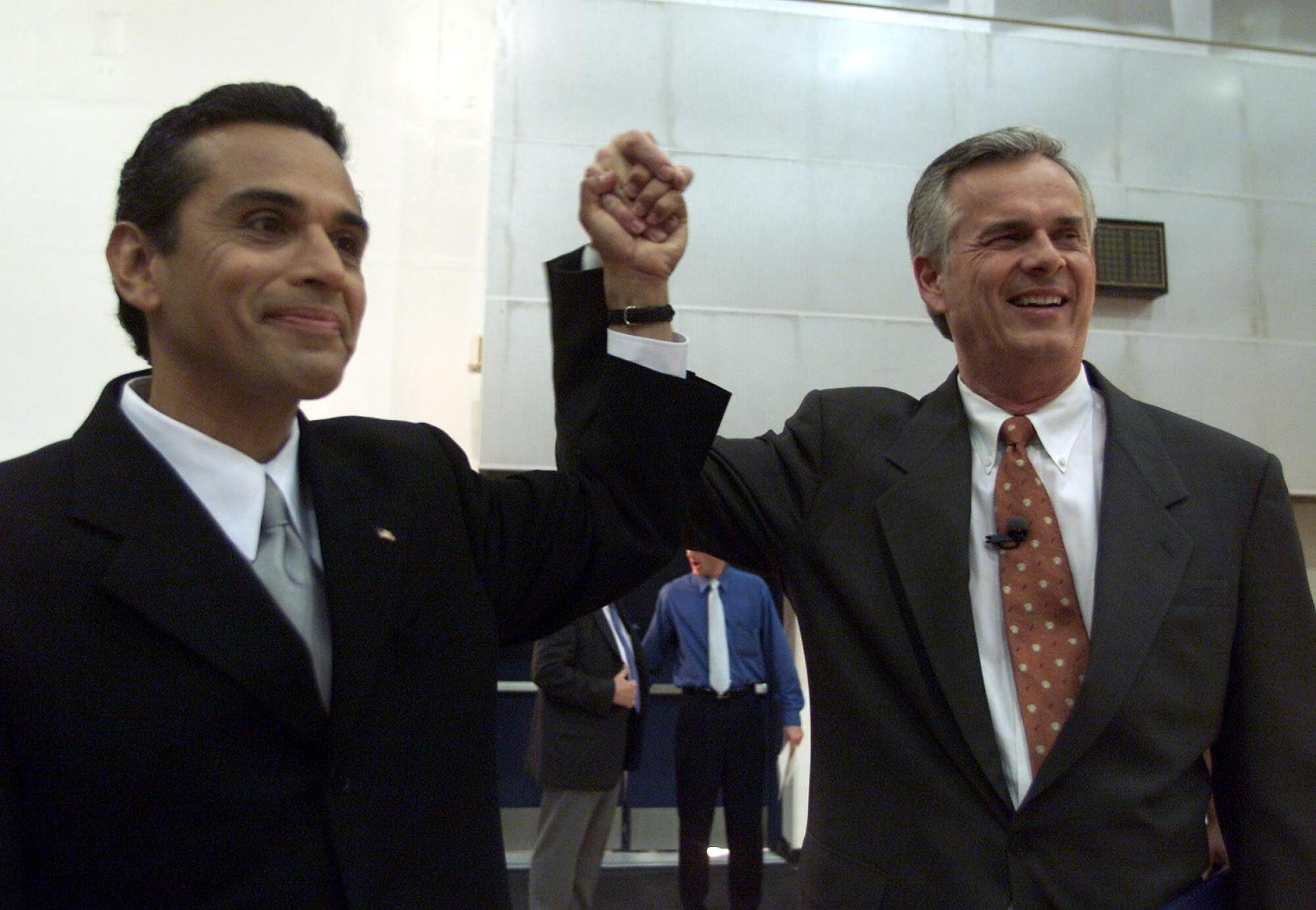
The ad referenced a letter of clemency that Villaraigosa had written to the White House on behalf of Caros Vignali, a convicted drug dealer who wanted his sentence commuted. Villaraigosa called the ad “reprehensible,” and accused Hahn of seeking to portray him as “like a gang member and a drug dealer.”
In the end, Hahn won by a slim margin, capturing more than 80% of the Black vote.
But Councilman Harris-Dawson of the 8th District, who worked as a canvasser on Villaraigosa’s 2001 campaign, said he thought the ad, while it may have turned white voters against Villaraigosa, actually helped him in the Black community. They viewed it as similar to the sort of racist dog whistle attacks many Black candidates faced.
“When that Vignali ad came out, it was the best thing that could happen [for Villaraigosa] with Black voters,” he recalled. “Because Black voters were like, ‘Oh, we get that’ ... it turned around people’s openness to Antonio.”
In 2005, Villaraigosa, by then a member of the City Council, took on Hahn again and beat him, in part by securing more votes in the Black community this time around.
But many strategists were also keenly aware that some Black Angelenos felt anxious about whether a Latino mayor would look out for their interests.
During the race, Villaraigosa’s director of campaign field operations, Anthony Thigpenn, who is Black, told The Times that some voters feared that “because it’s a Latino candidate, he’ll only take care of Latinos, and therefore African Americans will somehow be left out of the picture and diminished.”
“It’s a big challenge for Villaraigosa,” said Thigpenn. “It’s a big challenge for L.A.”
After Villaraigosa’s election as the first Latino mayor of the city in 130 years, Newsweek put the grinning mayor on the cover, under a banner headline that said: “Latino Power.”
But the new mayor took pains to pay heed to Black voters’ concerns, mentioning them in the very first sentences of his inauguration speech, and tipping his hat to Tom Bradley.
“When others said it couldn’t be done, you elected the first African American mayor of a leading American city,” he said. “And believe me, early in our campaign, there were those who said it wasn’t time for a Latino mayor. The faith you placed in me makes me so proud to be an Angeleno today, and I promise you, I will be a mayor for all the people.”
Race and redistricting
Throughout Villaraigosa’s eight-year tenure, the racial balance on the City Council remained as it had been since 2003: Three Black councilmembers from South Los Angeles, and four Latino councilmembers, two from the Eastside and two from the Valley. The remaining council seats were held by whites, but they were far from a monolithic bloc. Those from the Westside often championed progressive causes while those in the Valley tended to be more moderate or conservative.
But the Latino population continued to grow across the city, particularly in South Los Angeles. And this continued to lead to tensions, noted Earl Ofari Hutchinson, the Black author and activist, who noted that the “record of political empowerment and cooperation between Blacks and Latinos has been mixed.” They have fought together for improved neighborhood services, he said, but they have both also pushed to maintain and increase their own political power.
He noted that civil rights groups have “largely failed to engage the broad Black and Latino public in South L.A. on these flashpoint issues.”
Then the once-a-decade redistricting rolled around in 2012.
The City Council president at the time was Herb Wesson, the Black representative from the city’s 10th District.
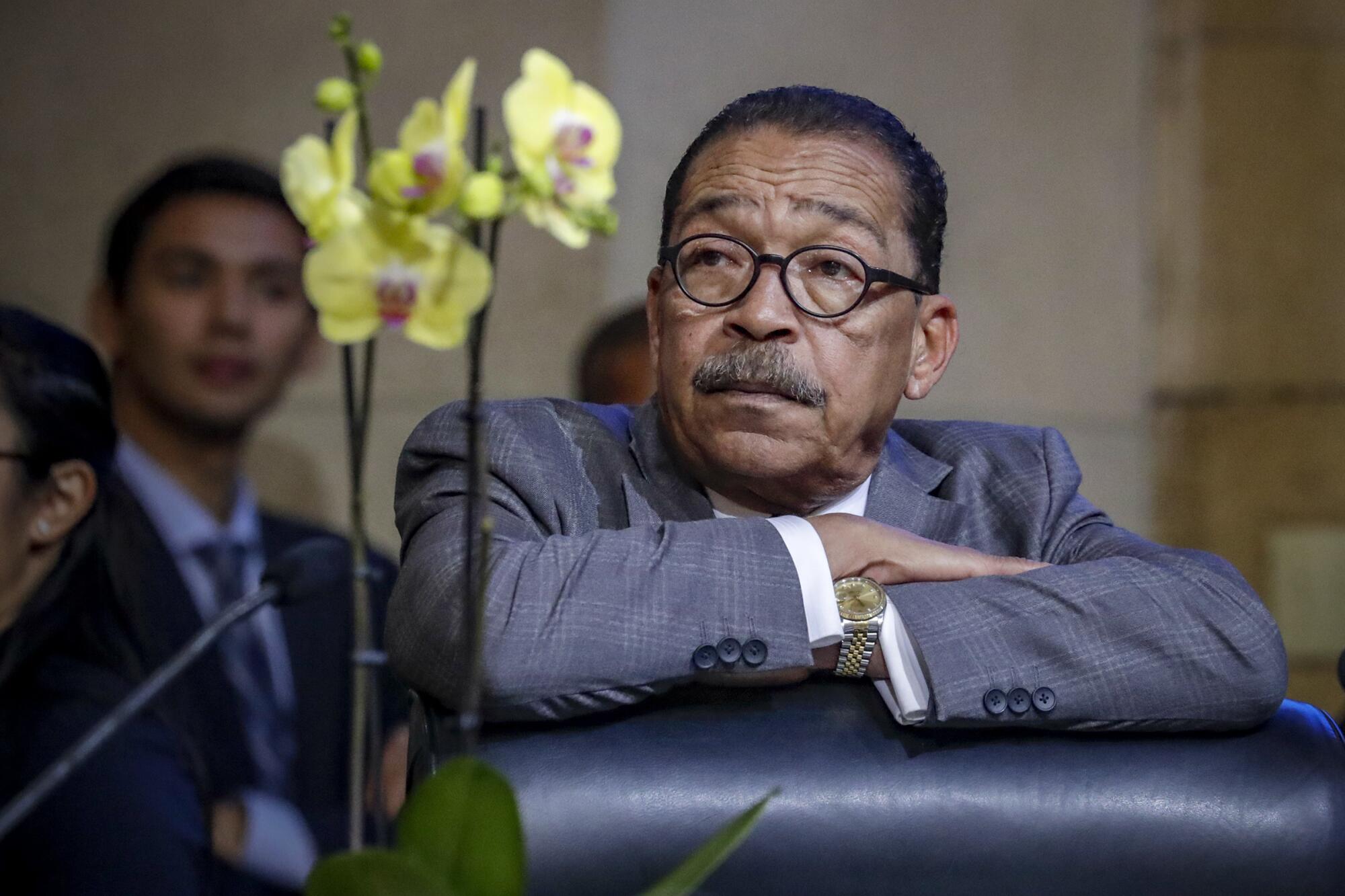
Wesson was elected as the council’s first Black president without the support of the council’s other two Black members, Parks, the former police chief who was now on the council, and Jan Perry, who represented the 9th District. All other members of the council voted for him.
When it came time to draw up new district lines, Wesson’s appointees on the redistricting commission teamed up with representatives of Mayor Villaraigosa and Councilman Jose Huizar to come up with a map that stripped Parks and Perry of some of the most cherished parts of their districts. Baldwin Hills and Leimert Park were taken out of the 8th District and put in Wesson’s district. Downtown was taken from Perry and given to Huizar, who represented the 14th District.
After some in South L.A. complained, Wesson defended himself, saying he had had to act because other councilmembers were trying to take advantage of the split among the council’s Black members. Wesson did not explain what he meant or provide evidence at the time.
“When I was elected president … the other factions said, ‘A-ha! The Negroes are fighting,’” Wesson told a mostly Black audience. His comments were captured on video.
“Brothers and sisters, it was me against 12 other members of the council,” Wesson continued. “I had no backup. I had no faction. And I did the very best I could with what I had. I was able to protect the most important asset that we as Black people have, and that’s to make sure that a minimum of two of the council people will be Black for the next 30 years.”
In 2019, Wesson stepped down from the council presidency to focus on a campaign for county supervisor, a race he ultimately lost to Holly Mitchell. He was replaced as council president by his No. 2, Nury Martinez, who had been elected in 2013 to represent a Latino seat in the Valley.
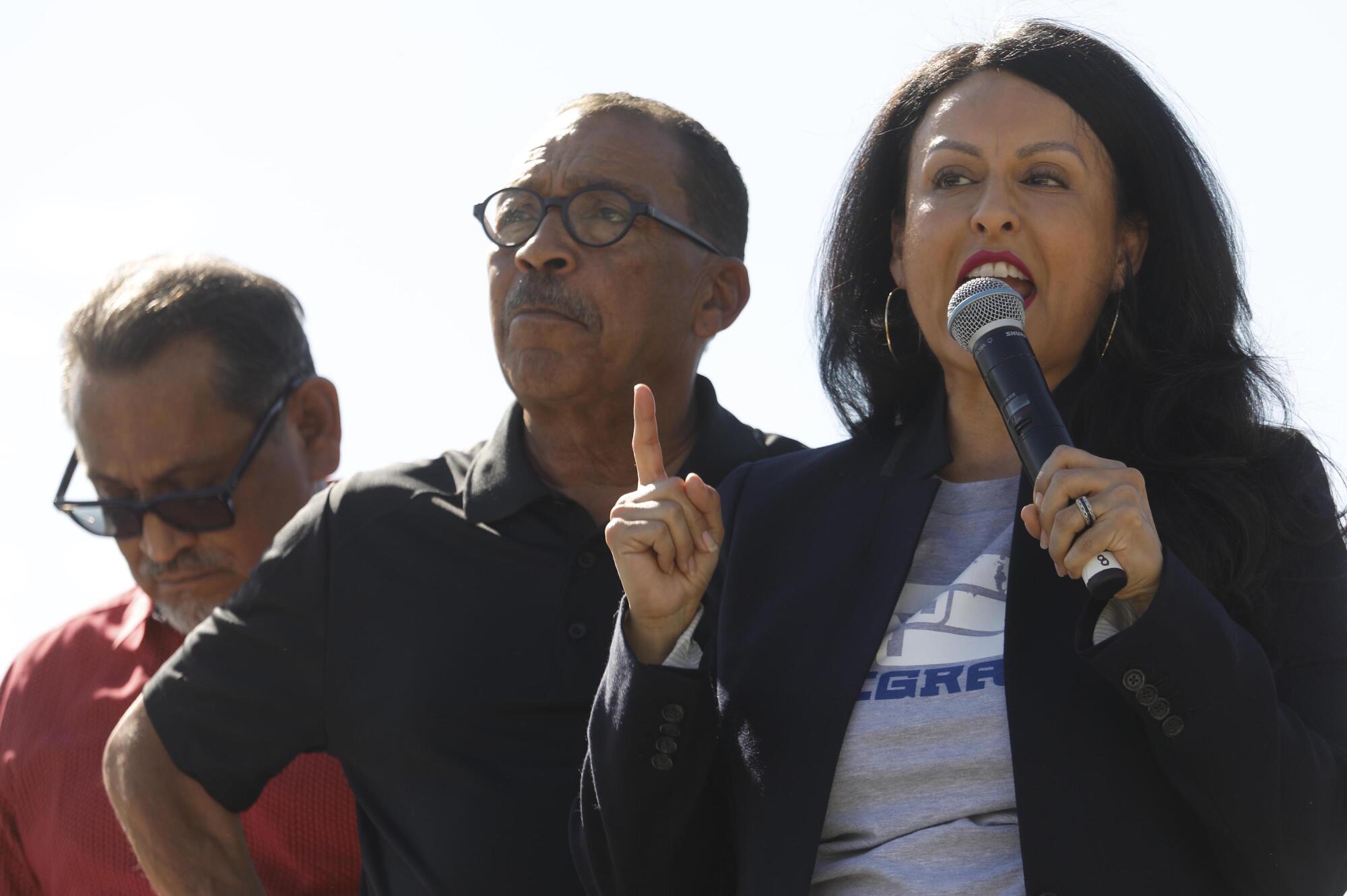
She became the first Latina to hold the post. She took power at a time when City Hall was in crisis, reeling from a federal corruption investigation. Huizar was indicted in 2020 on federal charges that he ran a sprawling pay-to-play scandal, and in the fall of 2021 Ridley-Thomas was indicted on conspiracy and fraud charges. Both have pleaded not guilty. Another former councilmember, Mitch Englander, who is white, pleaded guilty to a corruption charge in 2020. In the midst of this, the council again took up its once-in-a-decade redistricting
It was a meeting over district maps that led Martinez, along with Councilmembers Kevin de León and Gil Cedillo, to travel to the Los Angeles County Federation of Labor building last October for their now infamous meeting.
Racist leak brings pain, reckoning
When a recording of the conversation was leaked last week, snippets of it rocketed through Los Angeles City Hall and the city at large, exploding in hundreds of thousands of cell phones.
Marsha Colone, 57, who is Black and lives in South LA, said what upset her most was the possibility that the hateful words could jeopardize the unity Black and Latino people have forged together as they have fought side by side for equal rights for many decades.
“I thought we were working together,” she said. “It feels like they’ve split us up again.”
She said the recording has created distrust at a time when the country is already divided.
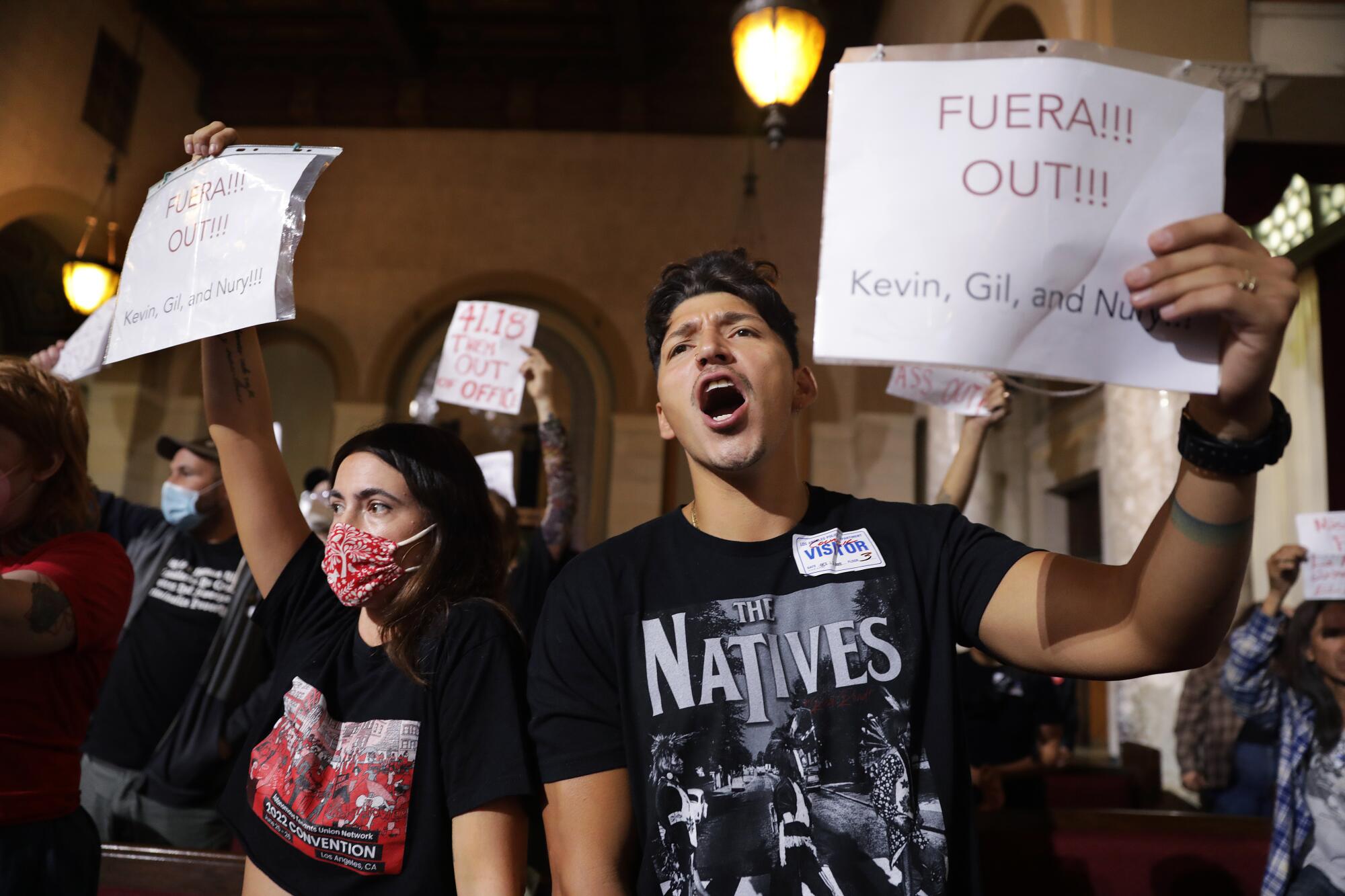
“People don’t know what or who to believe anymore,” she said. “The trust has been . . . challenged.”
She paused for a moment to stare at a group of Black and Latino students walking by her, together, smiling and laughing. “It’s nice to see them,” she said.
She said she believes the situation between her and her neighbors — two Latino families who live on either side of her — represent the real Los Angeles. “They treat me and my family like I’m part of theirs,” she said. “How they treat us and how we treat them won’t be affected by what Martinez said.”
But the tapes have already had an enormous political impact — and will continue to.
Former Councilman Alarcon said he feared Martinez’s comments had set the city back by “20 years in terms of Black-brown relations.”
Parks, the former councilman and police chief, said the racist talk was appalling, but “I suspect you had very similar conversations in 2012, it’s just nobody taped them.”
He added that the focus on the offensive comments was causing people to “somewhat ignore the larger issue,” which is that the councilmembers and the labor leader were trying to “configure the city for their benefit, as opposed to the benefit of the community.
Is it any wonder, he asked, why turnout is so low in city elections?
Price, the 9th District councilman whom Martinez was so vehement about protecting, publicly denounced his former ally this week, calling on her and the other two councilmembers to resign and saying: “Their actions are unforgivable and the damage is too much to bear.”
Martinez apologized on Sunday, took a leave of absence on Tuesday and resigned on Wednesday. All week, council meetings have been disrupted by activists who refuse to let things proceed until Cedillo and De León follow suit.
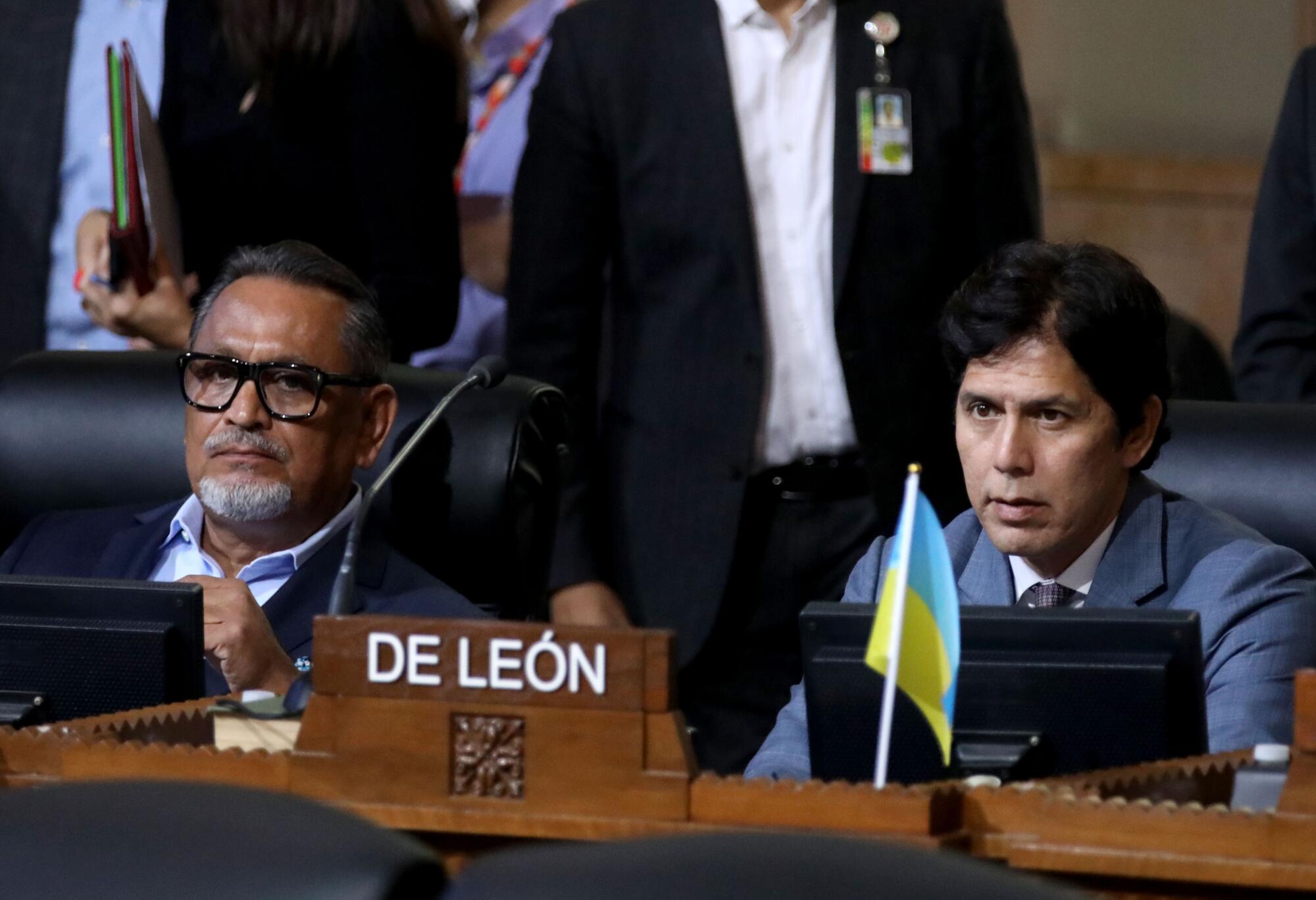
Even if he does not, Cedillo will be leaving office in December. He was defeated in the June election by a progressive challenger, Eunisses Hernandez, a graduate of Franklin High School in Highland Park, a traditionally Latino neighborhood that has been transformed in recent decades by gentrification.
She said the tapes reveal something she has long maintained: Martinez, De León and Cedillo were not multiracial coalition builders at all, despite their long history of cooperation with Black leaders. Instead, she charged, they are “very much embedded in racist values and thoughts and language.”
Hernandez said the next generation of Black and Latino leaders who seek office — such as her friend state Assemblyman Isaac Bryan, who is Black — recognize that the divide between the Black and Latino communities has harmed both.
Bryan was among those who went to City Hall on Tuesday to decry the sentiments on the tapes.
The racist comments on a recording that rocked Los Angeles City Hall ensnared Councilman Kevin de León in controversy. The tape also revealed an undercurrent of ambition and grievance in his political career.
“Latino power building can’t be rooted in the erasure of Black representation,” he said. “That’s a form of political violence akin to the strategies of white supremacy.”
Nuño, the business owner from the 9th District who failed to get backing from the Latino establishment for his 2017 council run, has been following it all closely.
He said he may run again for a seat representing District 9.
“This is about seizing the moment to transform L.A. politics,” he said. “I see multiracial coalition building, and that is going to be the future not just in South Los Angeles, but across the city. This is the future of Los Angeles.”
Times staff writers Kailyn Brown, Benjamin Oreskes, Rachel Uranga, James Rainey, and Melanie Mason contributed to this report.
More to Read
Sign up for Essential California
The most important California stories and recommendations in your inbox every morning.
You may occasionally receive promotional content from the Los Angeles Times.

